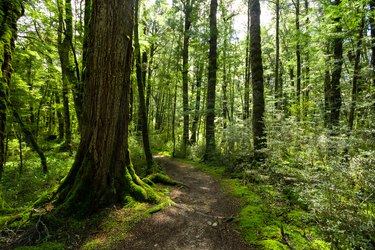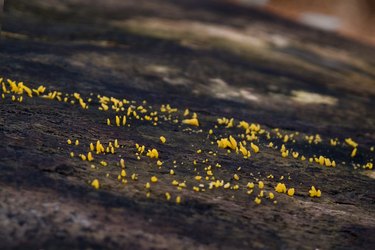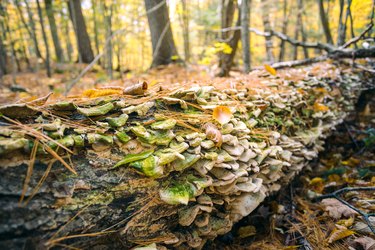
There are a few types of orange fungus that grow on trees. A common type of orange tree fungus is the jelly fungi (Tremellales), which looks soft to the touch or wet like jelly but is actually very hard and can only be cut by a very sharp knife. The jelly fungi family includes members like fairy butter, horned calocera, witch's butter and yellow jelly fungi.
Pore fungi (Polyporaceae and Ganodermataceae) also occur on trees in shades of orange. Pore fungi members look like brackets or shelves attached to living or dead trees. Orange pore fungi members include sulphur polypore and honeycomb bracket fungus. All orange colored types of jelly fungi and pore fungi thrive in the United States and Canada.
Video of the Day
Video of the Day
Honeycomb Bracket Tree Fungus (Favolus alveolaris)
The Honeycomb bracket fungus grows singly or in small clusters on dead broad-leafed tree trunks in the Eastern United States and Southern Canada. This orange tree fungus gets its name from the white-yellow honeycomb-like pores on the underside of the bracket. The Fungus is yellow-red with small flat scales and a small white-yellow stem.
Sulphur Polypore Tree Fungus (Polyporus sulphureus)
The sulphur polypore fungus is a type of pore fungi often referred to as bracket fungi because of their bracket or shelf-like appearance. The sulphur polypore can be found growing in large colonies on the trunks of broad-leaf and conifer trees in most of the United States and Western and Southern Canada.
The brackets of the sulphur polypore fungus sprouts from very short stems and is two to 20 inches wide. The fungus is orange to yellow in color, becoming pale yellow with age. The edges are ruffled and are a slightly paler in color than the top of the fungi. The underside is yellow, which also becomes paler with age.
Fairy Butter Tree Fungus (Dacrymyces palmatus)

Fairy butter is a member of the jelly fungi family. This orange tree fungus dries out for periods of time, then spreads its spores when soaked with water. Distinguished by its orange- red jelly-like clumps that look like flower petals that have been folded. The fungus is hard but becomes watery and soft as it ages. The fungus grows one-half to two-and-a-half inches wide on conifer stumps and logs in the Eastern sides of the United States and Canada.
Horned Calocera Tree Fungus (Calocera cornea)
The horned calocera fungus is a yellow-orange fungus that grows upward in horn-like projections. The horns reach one-quarter to three-quarter inch tall and look like they are made of a jelly-like substance. When the horns are dry they are hard and can become brittle. The horned calocera grows on dead and dying trees in most of the United States and Canada.
Witch's Butter Tree Fungus (Tremella mesenterica)
Witch's butter is part of the jelly fungi family, which are fungus that dry hard then grow by setting out new spores when soaked with water. The University of Wisconsin shares the lore relative to how this orange tree fungus got its common name. According to some legends originating in eastern Europe, witch's fungus shows up on your home's entrance or the front gate if a witch has put a spell on you.
Often jelly fungi grow in the winter on dead broad-leaf tree trunks when the melting snow dampens the wood and helps them to multiply. Witch's butter is a orange-yellow fungus that looks like a soft glob of butter or a brain, but is hard to the touch. It grows three-quarters to four inches wide with deep wrinkles and folds. It thrives in most of the United States and Canada.
Yellow Jelly Tree Fungus (Guepiniopsis alpines)

A member of the jelly fungus family it soaks up water in order to multiply. Yellow jelly fungus is one-quarter to one-half inch wide with a yellow-orange round-oval jelly-like top and small slender stem. The yellow jelly fungus grows in small clusters on conifers on the West Coast of the United States and Canada and around the Northern Great Lakes region.